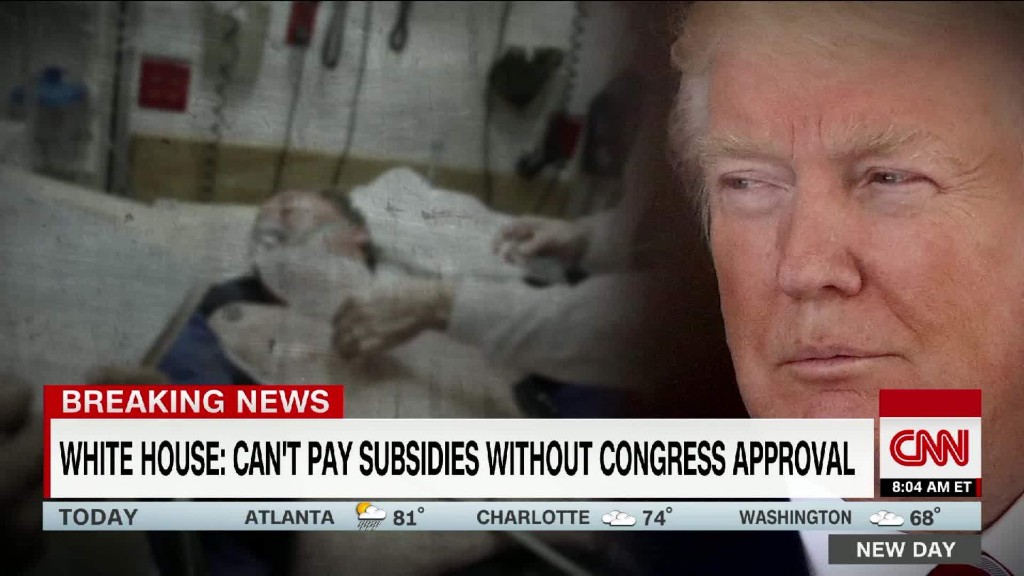
President Trump and congressional Republicans have long vowed to lower health insurance premiums.
But Trump's decision to halt funding for Obamacare's cost-sharing subsidies last week will actually raise rates next year. Plus, the move increases what taxpayers will have to shell out to support Obamacare.
Many states had already allowed insurers to steeply hike Obamacare premiums for 2018, anticipating that Trump may cut off federal support for the subsidies, which reimburse insurers for reducing the deductibles and co-pays of lower-income enrollees. In California, for instance, carriers will levy a surcharge of up to 27% on silver-level plans.
Some insurers are spreading the hikes out across all their plans, but others are limiting it to just silver-tier polices -- the plans eligible consumers must purchase to receive the cost-sharing subsidies.
Related: Trump will end health care cost-sharing subsidies
Regulators in some states that hadn't taken this precaution swiftly moved to boost rates after Trump's announcement.
In Oregon, state officials on Friday ordered insurers offering policies on the exchange to boost their silver plans premiums by an additional 7.1% for 2018. This will make up for the $49 million in cost-sharing subsidy funding that they will lose.
Rate increases in Arkansas will be roughly double what they would have been had the cost-sharing subsidy funding continued. The average premium at insurer Ambetter will rise 21.4% next year, instead of 9.9%, the state insurance department said Friday. Arkansas Blue Cross Blue Shield will boost rates an average of 14.2%, instead of 7.8%.
Pennsylvania regulators said Monday that rates will jump 30.6%, on average, rather than the 7.6% hike that was expected had Trump continued funding the subsidies.
"This is not the situation I hoped we would be in, but due to President Trump's refusal to make cost-sharing reduction payments for 2018 and Congress's inaction to appropriate funds, it is the reality that state regulators must face and the reason rate increases will be higher than they should be across the country," said Acting Insurance Commissioner Jessica Altman.
Some states haven't yet decided what to do. Maryland is in this boat.
"We are still reviewing our options," Al Redmer, Jr., the state's insurance commissioner, told CNNMoney.
Related: Trump kills key Obamacare subsidies: What it means
CareFirst BlueCross BlueShield, one of two insurers on the Maryland exchange, is already asking regulators to raise rates. Earlier this year, it had requested premium hikes of 50.4% and 58.8%, on average, for its HMO and PPO policies, respectively. It was granted increases of 34.5% and 49.9% for those polices.
Without another set of premium increases, the company expects to lose an additional $50 million in the individual market in 2018, on top of the $200 million it projects it will lose this year, said Michael Sullivan, CareFirst's spokesman. Regardless, it plans to stay on the exchange.
North Dakota, on the other hand, is bucking the trend. Insurance Commissioner Jon Godfread said Monday that he will not allow insurers to raise their rates to make up for the funding loss because it would hurt enrollees who don't receive premium subsidies.
Blue Cross Blue Shield of North Dakota, which will increase premiums by nearly 23% next year even without the additional boost, said it will continue to offer policies. But it expects to raise rates even further for 2019 to compensate for the additional costs.
The state's other insurer, Sanford Health Plan, is still weighing its options, a spokesman said. It was granted a rate increase of nearly 8% for 2018.
A third insurer, Medical Health Plan, announced last month it would not participate in the state's exchange next year because the insurance department would not let it price in the loss of the subsidy funding.
Most Obamacare enrollees, however, won't feel any hikes in rates. That's because they can still receive premium subsidies that reduce their rates to less than 10% of their household income.
Instead, taxpayers will foot the bill. The federal government will have to spend an estimated $7.2 billion more next year because it will have to shell out more in premium subsidies to cover these higher rates, according to an Urban Institute analysis.


